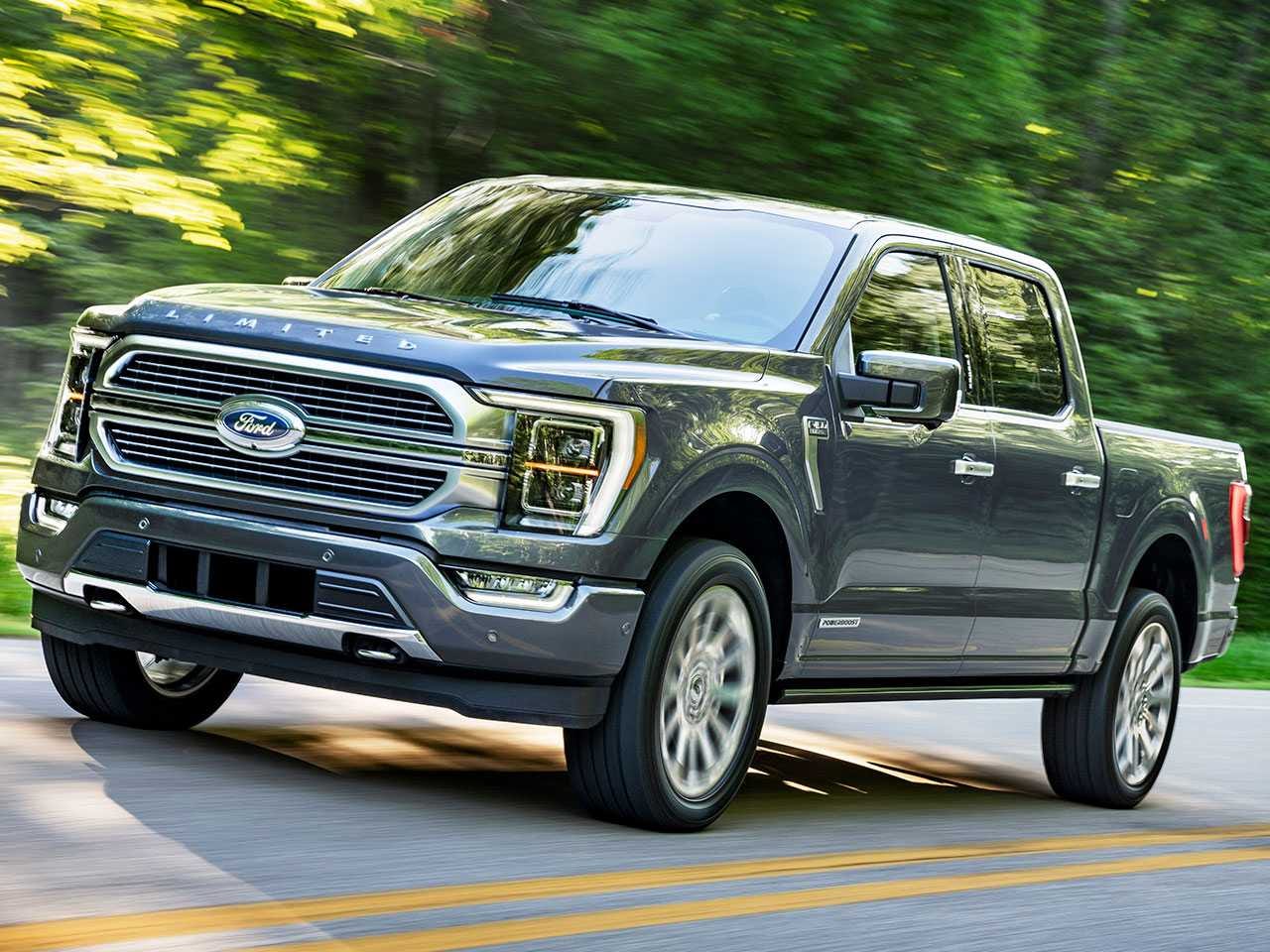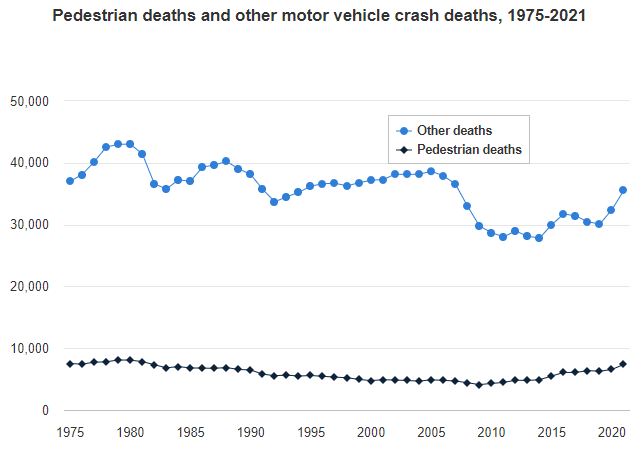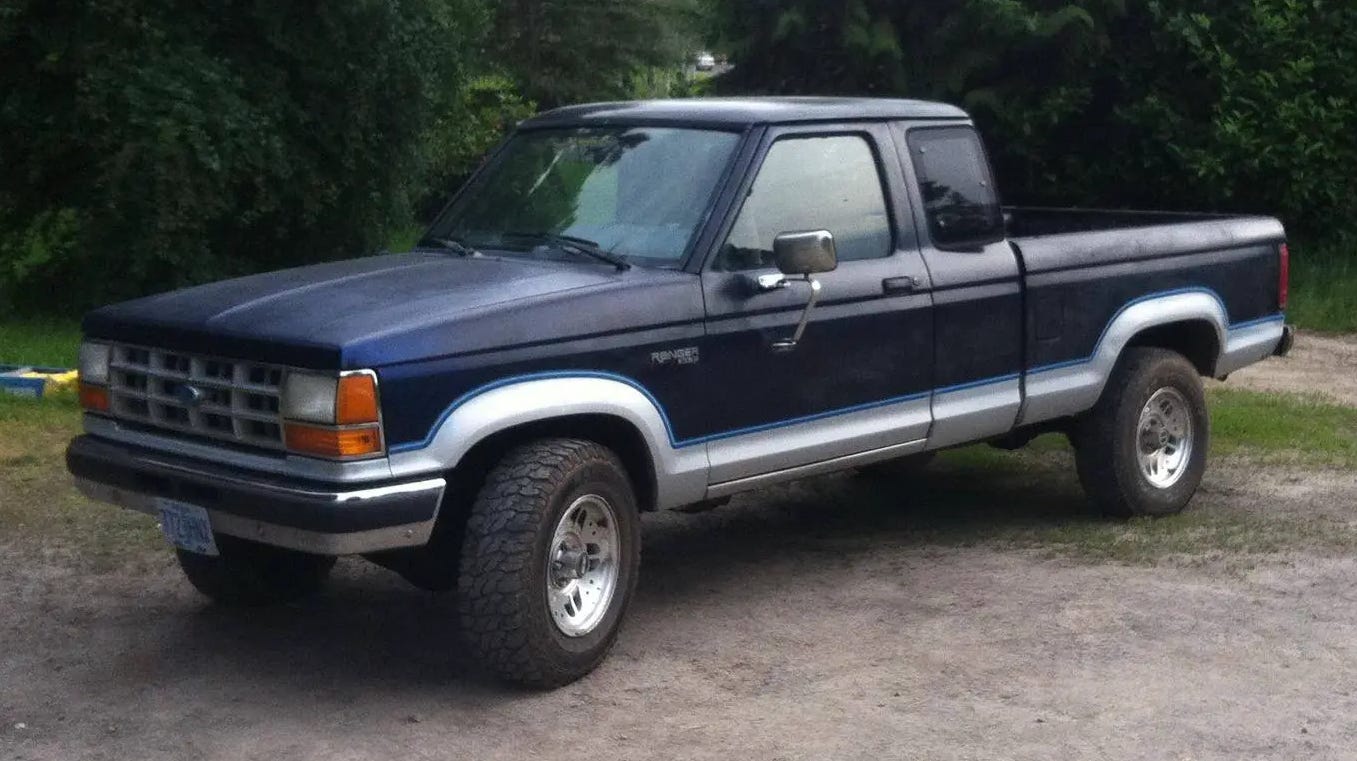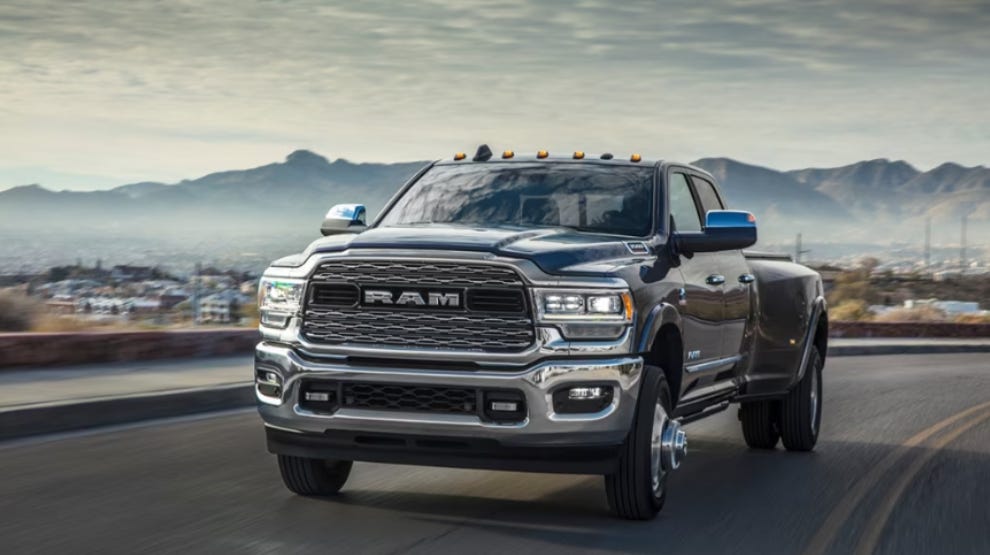Americans Love Trucks. What Does That Say About Us?
PLUS: Are the Denver Nuggets the Next NBA Dynasty?
Maybe this is another weird follow-on effect from shutting the country down for about a year, but since the pandemic, it seems Americans have become worse drivers. That’s an anecdotal observation, but the stats seem to back me up. Between 2008 and 2019, the number of people in the United States who died in a motor vehicle accident not only never exceeded 40,000 people (as it did every year prior except 1992) but also never exceeded 37,806 people, which was the 2016 total. In 2020, however—the year we were all in lockdown—the number of motor vehicle deaths jumped past 39,000 people, and then rose to 42,939 people in 2021. Those deaths included 7,388 pedestrian deaths, which was about 800 deaths higher than in 2020 and over 1,000 deaths higher than in 2019. (Annual pedestrian deaths have slowly crept upwards since hitting a low of 4,109 deaths in 2009.)
It's odd 2020 would have been such a deadly year on American roadways because most of us weren’t driving much. One theory is that the empty streets encouraged people to speed, which is a major factor in many fatal accidents. Yet the sharp increase is also shocking because the annual number of deadly car accidents has for the most part been trending downwards for the past fifty years, a decline many attribute to new seatbelt laws, an aggressive push to reduce drunk driving, and enhanced safety features in cars. (We probably could have seen even steeper declines if not for the rise in distracted driving deaths resulting from the use of cell phones while driving.)
But tallying automobile-related deaths is the most extreme way we might measure the quality of driving. When I say it seems Americans have become worse drivers since the beginning of the pandemic, I’m making a more general observation about the driving habits of Americans (or at least my neighbors) over the past few years. This is my own metric, but a week does not pass in which I do not have to deal with at least one driver who wanders outside their lane lines. My wife regularly reports similar incidents from her commute. Two weeks ago, I was in the right lane when a hatchback sedan slowly passed me in the center lane and began fading into mine. I honked, which got the driver to straighten back up, but that wasn’t the end of it. Not wanting to end up next to this guy, I pulled in behind him only to watch him cross lane lines two more times, all in a 2-3 mile stretch of road. I don’t think it was a case of distracted driving, as I could see his cell phone mounted on his dash with a map app displayed. Maybe he was tired or inebriated, but it was also 1:30 in the afternoon. Who knows. All I’m saying is I regularly have to account for drivers who can’t stay in their own lane, which wasn’t a common problem prior to 2020.
I’ll add this observation as well: When it comes to lane violations, the biggest culprits aren’t sedans or even commercial/industrial vehicles like semi-trucks or garbage trucks. (Municipal busses have always been their own beast.) It’s pickup trucks. You may already have a sense for this, but pickups these days are huge. Even mid-range pickup trucks are rather hefty. See one in a parking lot and you’ll notice they’re often as wide as the spot they’re in and stick out further than other cars into the lane between rows, making them difficult to park next to and hard to maneuver around when a lot is busy. Their girth does not leave a lot of room for error if one should pass beside you on a multilane road here in Maryland’s DC suburbs.
Full disclosure: I once drove a pickup truck. In the late-90s, I bought a 1990 Ford Ranger, and traded that in for a 1998 Dodge Ram in 2005. In the end, I preferred the more compact Ranger, as I could still haul everything back and forth between home and college in the relatively small cargo bed.
The Ram, on the other hand, could feel like a barge at times, and I didn’t get any benefit from the extra size. I’d love to own a small truck like that Ranger again. Part of it’s the farm boy in me, but I also just like the idea of driving a vehicle that’s useful, that can haul large items or stuff I don’t want messing up the interior of a car, and that could come in handy if a friend needed help moving something.
I am far from alone in my fondness for pickup trucks. The highest-selling vehicle in the United States over the past 40+ years is the Ford F-Series pickup. According to Car and Driver, in 2022, the three highest-selling new vehicles in the U.S. were the Ford F-Series pickup, the Chevy Silverado pickup, and the Ram pickup; the other pickups in the top ten were the GMC Sierra (#6) and the Toyota Tacoma (#8). Kelley Blue Book reported trucks outsold non-luxury cars for the first time ever in the U.S. in 2020, although that is a deceiving statistic: Trucks have historically held about 20% of the market, but sedan sales have fallen from nearly 50% of the market in 2010 to around 20% now. (SUVs make up nearly 60% of new car sales in the U.S., which is almost double the market share from 2010.)
Cars no longer grip the American imagination the way they did in the second half of the twentieth century. No one writes odes to “Mustang Sally” or compares a lover to a “Little Red Corvette” anymore. The only vehicle Americans do romanticize these days is the pickup truck. Car companies both shape and play off this myth in their truck commercials:
Trucks represent (horse)power, ruggedness, and rugged individualism. They are working-class vehicles, designed for hard work and hard tasks, but, as a matter of both financial necessity and design, are also used for play. A truck is a farmer’s most important tool, the modern-day equivalent of a cowboy’s horse, the piece of technology that connects us to our rural heartland ideal, a central image in hundreds of country songs. When we aim to escape civilization, the pickup is the vehicle we drive into the wilderness, and once we get there, we use it to drive off-road into unexplored terrain. Trucks, in other words, represent freedom: The sort of freedom earned through work, that liberates us from work, that grants us unlimited mobility, that empowers us, that is our birthright as Americans.
It should be unsurprising, then, that so many Americans long to own pickups. Purchasing a minivan, compact SUV, or sedan doesn’t fill an almost spiritual need the way purchasing a truck does for millions of Americans. Forty years ago, an American would have bought a truck for a utilitarian, work-related reason; these days, many buy them to indulge in their conception of the American Dream.
The irony is that by elevating the pickup to the status of American icon, Americans are stripping the pickup of the practical virtues that turned it into an icon to begin with. Trucks are useful for people who need to regularly haul or tow stuff, but that’s not what most people buy them for today. As a truck owner told CBS News in December 2022, “I don’t need a truck for anything. I just drive it to get from point A to point B.” A Strategic Vision survey of Ford F-150 owners found 82% of owners frequently used their truck for shopping and errands while 52% frequently used it for their regular daily commute, but only 28% frequently used it to haul something and only 7% said they frequently used it for towing. (Alternately, 63% percent of respondents said they rarely or never used it for towing.) Another Strategic Vision survey found 35% of truck owners never even put anything in the truck’s bed, which is odd, since the bed is what makes a pickup a pickup.
Because consumers are more interested in trucks as status symbols and wish fulfillers than as vehicles that serve practical purposes, car companies have responded by altering the design of pickups. The interior features of trucks more often resemble those found in luxury cars than in the sort of vehicle a dirty, sweaty farmer or construction worker might drive home after a long day of work. The extended cabs on trucks have morphed into full-sized back seats big enough to haul the family around in. To accommodate the bigger cab size as well as two more doors, car companies have shrunk the often unused bed. Today, Ford F-150s are roughly 2/3 cab and 1/3 bed, nearly the exact opposite ratio of the original F-150s.

Because trucks have become status items, car companies are also able to charge considerably more for them. It is estimated General Motors made at least $17,000 in profits in 2019 off the sale of a single new Silverado that retailed for around $36,000. One has to wonder if the Joad’s would travel in a pickup truck in a modern-day adaptation of The Grapes of Wrath. A little too uppity, perhaps?
If luxe interiors, smaller beds, and soaring sticker prices run counter to the ethos of a pickup, car makers have compensated by making trucks bigger. Truck owners may rarely use their trucks to haul or tow something, but those same truck owners most definitely want pickups that look like they could haul or tow the hell out of anything they might conceivably tow. The average weight of a pickup has increased by 32% since 1990, which, according to the science publication Nature, is like adding the equivalent of a grand piano and the pianist to the weight of a truck. (New EV trucks weigh even more on account of their batteries.) Pickups have also grown 24% taller since 1990. A new Ford F-250 Super Duty pickup weighs 7,500 pounds (more than twice as much as a Toyota Camry) and is 55 inches tall at the hood (which is roughly the height of most sedans as well as the average third grader.) The frame of a Ford Super Duty F-550 pickup is used as the platform for armored military and law enforcement vehicles. Vice notes the dimensions of today’s best-selling pickups and SUVs are nearly as big as the M4 Sherman tanks the United States used in the Second World War.
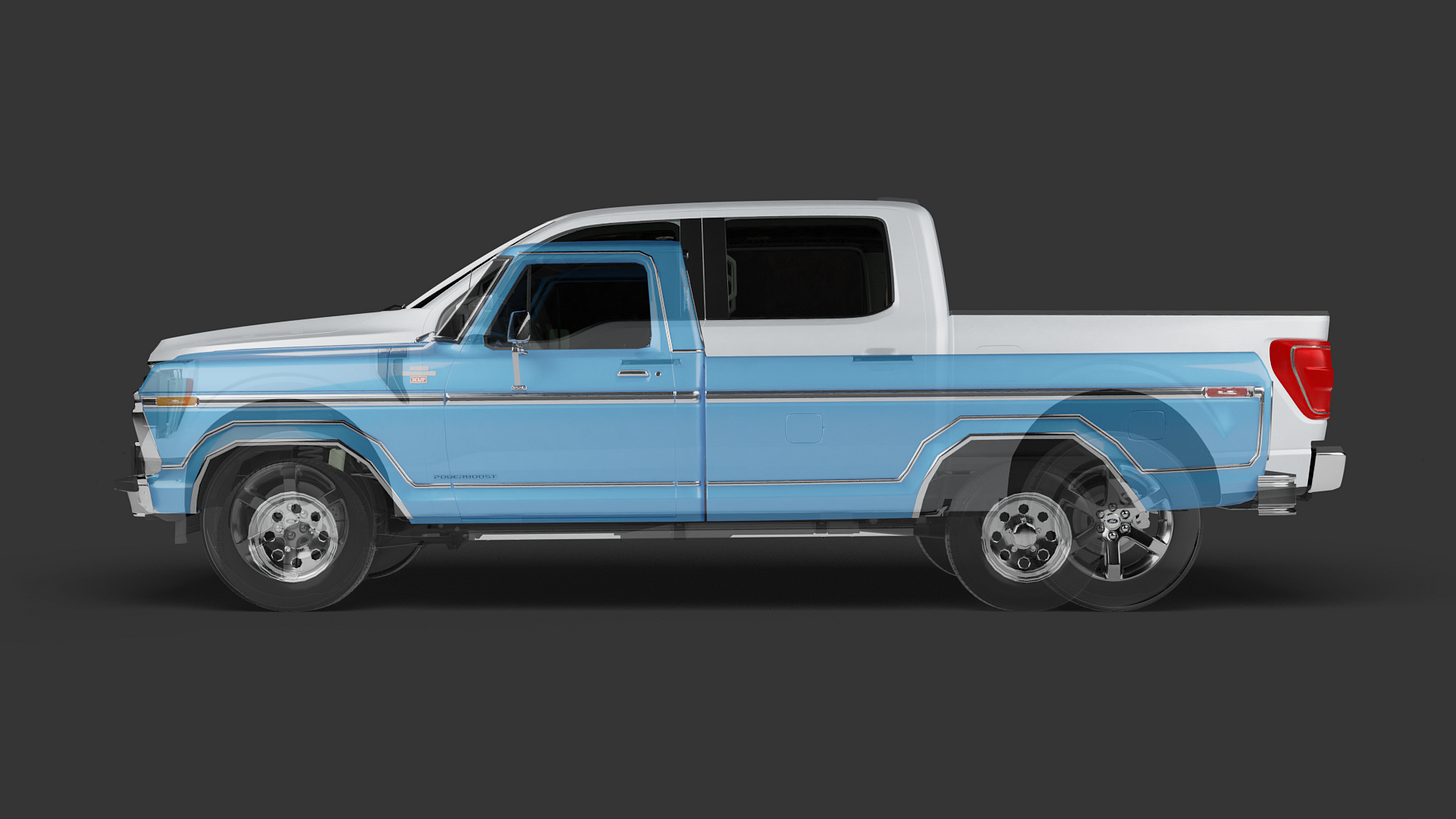
That size is a problem. I’ve already mentioned how oversized pickups domineer roads and parking lots. (Their owners also have found they have a hard time fitting them into their garages.) More significantly, their size also makes them a particularly deadly type of vehicle. No one wants to get into any sort of serious car accident, of course, but pickups for decades have been about 160% more likely to kill another driver in a collision than sedans, and car drivers are 2.5 times more likely to die after crashing into a pickup than into another car. The bigger the vehicle, the more likely a pedestrian will die after being struck by one as well. Pickups, for instance, are only involved in 6% of all pedestrian accidents but account for 13% of all pedestrian deaths, while SUVs are involved in 17% of all pedestrian accidents but account for 40%(!) of all pedestrian deaths. (My guess is pickups kill fewer pedestrians than SUVs because they’re not driven as often around pedestrians as SUVs currently are, which does not recommend trucks for urban driving.)
It's not just the weight of pickups and SUVs that make them deadlier or more accident prone than sedans. I personally think pickups might be too much vehicle for the average driver to operate safely. Others wonder if, despite additional safety features, their design makes it more difficult for drivers to spot pedestrians or peer into blind spots. Critics have focused on the height of pickups as well. While sedans tend to strike pedestrians in the legs during accidents, pickups strike adults in their torsos and children in their heads and bodies, leading to more fatal encounters (two times the rate of sedans.) Someone struck by a pickup is more likely to be rolled beneath the wheels of the vehicle as well, which increases the likelihood of a fatality.

Finally, height seems to be a factor in “frontover” deaths (when a car drives over someone in a parking lot or driveway) as 80% of all such deaths involve a truck, van, or SUV. It’s just easier for a child who has moved in front of a pickup to go unnoticed when the driver can’t see the space directly in front of the vehicle. Also worth remembering: Approximately 70% of all frontover deaths involve someone the driver knows.
Harming someone they care about might make someone think twice before buying a pickup. Yet I worry many of the statistics I just cited about traffic fatalities might actually reinforce someone’s desire to purchase a truck. That’s because I suspect people aren’t only interested in owning oversized pickups as a way to live out the American Dream. I also think people like pickups because they know if they’re ever in an accident, the poor sap who collides with them is more likely to get hurt than they are. In an article for The Atlantic, Angie Schmitt relates a comment made by an adman at Chrysler to Keith Bradsher for his 2002 book High and Mighty. The adman told Bradsher he believed most Americans think of the road as a “battlefield” and tell themselves (but not others) that, “If there’s a crash, I want the other guy to die.”
This is the point where faithful readers might expect me to call for a ban on oversized pickup trucks. I do think it would be a good idea to shrink truck and SUV sizes, lessen our dependence on automobiles, and make neighborhoods more pedestrian-friendly. But I understand why farmers, ranchers, construction workers, and other laborers who need a vehicle that can traverse rugged terrain and haul and tow heavy objects would want a pickup. If you’re one of those people, keep on truckin’ (although, I would add, I know and I’m almost certain you know as well that you probably don’t need a truck as big as the one you’re currently driving.)
My gripe instead is with the suburban cowboy treating the highways like the Wild West as they make their commute to the office park. It’s dispiriting to find Americans so intoxicated by freedom that they use it in ways that endanger the lives and liberties of others. Perhaps the citizens of a free society are destined to see peril all around them in the unregulated state of nature they inhabit with their fellow citizen/stranger. It’s tragic that in our time it seems we respond to this condition by acting in ways that make that world ever more dangerous. That means many of us will buy a full-size pickup to inflict more damage on the person we’re worried will run into us without thinking about how much more likely we are now to run over the neighbor girl who we didn’t see stop her trike in front of our truck while we fiddled with our vehicle’s Bluetooth.
So to paraphrase an article written by Brett Berk on this topic, rather than place those you encounter on the road at a heightened risk of injury so you can get your John Dutton on, just buy the hat.
Signals and Noise
For your amusement: “I Don’t Want to Live in a Country Where Trump Could be Held Accountable” by Rex Huppke of USA Today (“Now that my favorite president, Donald Trump, is facing a 37-count indictment from the feds, I join with my brothers and sisters in MAGA, and with all sensible Republicans, in saying this: I’m not sure I want to live in a country where a former president can wave around classified documents he’s not supposed to have and say, ‘This is secret information. Look at this,’ and then be held accountable for his actions. I mean, what kind of country have we become? One in which federal prosecutors can take ‘evidence’ before a ‘grand jury,’ and that grand jury can ‘vote to indict’ a former president for 37 alleged ‘crimes’? Look at all the other people out there in America, including Democrats like Hillary Clinton and President Joe Biden, who HAVEN’T been indicted for crimes on the flimsy excuse that there is no ‘evidence’ they did crimes. THAT’S TOTALLY UNFAIR!”)
By Eric Levitz of New York: “The DOJ Went Easy on Trump for Political Reasons” (“In reality, however, the notion that the DOJ is selectively prosecuting Trump for political reasons is not merely wrong but the very opposite of the truth: As a matter of fact, the federal government has been affording Trump extraordinary leniency, likely as a product of political considerations.”)
Following Trump’s indictment, a Morning Consult Poll found 59% of Republican voters favor Trump as their party’s 2024 presidential nominee. Second place is Ron DeSantis with 19%.
Hillary Clinton, on Pod Save America: “The response that we’ve seen in polling from Republicans suggests that they’re gonna stick with [Trump] – that it’s more of a cult than a political party at this point. And they’re gonna stick with their leader.”
Newsmax host John Huddy to Sarah Palin: “I was with the Trump motorcade yesterday. And I would say that the people at Versailles, at the Cuban restaurant [Trump stopped at after his court hearing – I wouldn’t call them cult members. Would you?
Sarah Palin: “No. You know, the definition of a cult is a group of people who are excessively supporting one another and a cause – all about conformity and compliance and intolerance of anyone who doesn’t agree with what their mission is.”
Me:
By Ronald Brownstein of CNN: “How Republicans Are Stitching Their Own Straitjacket on Trump Indictment”
By Matthew Yglesias of Slow Boring: “The Orange Man is Bad” (“His con is not that he’s convinced conservatives that he’s honest. It’s that he’s convinced conservatives that his lying and shamelessness is a superpower that he deploys on behalf of their issues and causes. And it is true that he has at times deployed dishonesty and shamelessness to advance conservative causes. But much more frequently, he deploys dishonesty and shamelessness to advance himself, often at the expense of conservative causes.”)
By Jeffrey Blehar of National Review: “Trump’s Indictment is Worse Than You Think It Is” (“Trump is nailed dead to rights, and what matters most of all is that it’s not on some technical offense. What he was doing, before only a physical raid on Mar-a-Lago stopped this madness, turns out to have been less an act of mere carelessness than an active threat to United States national security, one fueled solely by Trump’s demented behavior and sense of self-entitlement.”) Also by Blehar: “Pardoning Is Not Enough: We Must All Perform Seppuku for Donald Trump”
By Fintan O’Toole of The New York Review: “The Ultimate Deal” (“Secrets are a kind of currency. They can be hoarded, but if kept for too long they lose their value. Like all currencies, they must, sooner or later, be used in a transaction—sold to the highest bidder or bartered as a favor for which another favor will be returned. To see the full scale of Donald Trump’s betrayal of his country, it is necessary to start with this reality. He kept intelligence documents because, at some point, those secrets could be used in a transaction. What he was stockpiling were the materials of treason. He may not have known how and when he would cash in this currency, but there can be little doubt that he was determined to retain the ability to do just that.”)
By Stephen Collinson of CNN: “Trump’s Main 2024 Election Goal is Now to Save Himself” (“Trump’s legal defense strategy is now entirely fused with his electoral one. His bid to regain the White House is no longer a mere political campaign but has now become about self-preservation. As his court battles grind on, his biggest aim appears to be recapturing the presidential authority that might give him the power to make his potential criminal liability – and even the threat of jail time, if convicted – go away.”)
A key source of evidence and a key witness against Trump in his upcoming trial concerning his retention of classified documents may be Trump’s own lawyer, M. Evan Corcoran.
Meanwhile, a federal judge has allowed E. Jean Carroll to amend her lawsuit to seek millions of dollars more in damages from Trump stemming from the comments he made about her during his CNN townhall.
Aaron Blake of the Washington Post writes that Republican South Carolina Senator Lindsey “Goose” Graham and other Republicans are defending Trump by arguing, “Hey, at least he’s not a spy.” That’s kind of like saying a docent at the Louvre shouldn’t be charged with stealing the Mona Lisa so long as they didn’t give it away to someone else.
“I don't think Senate Democrats, if you had video of Joe Biden murdering children dressed as the devil under a full moon while singing Pat Benatar, they still wouldn't vote to convict.”—Texas Senator Ted “Teddy Cancun” Cruz
Congressional Republicans are looking at ways to strike back at the Department of Justice and the FBI in retaliation for the federal government’s indictment of Trump.
Still, when it comes to Trump’s latest legal woes, it appears there’s more consternation among Republicans this time around. And, as David Leonhardt of the New York Times points out, even though Trump still retains solid support among Republicans, there is a growing number of Republicans who take the charges seriously.
House Speaker Kevin McCarthy cut yet another deal with the far-right Freedom Caucus to get the House up-and-running again (a deal that would call on him to renege on his debt ceiling deal with Biden) but Ursula Perano of The Daily Beast writes he is only sowing the seeds of his own demise.
But when it comes to reneging on McCarthy’s debt ceiling deal with Biden, Senate Republicans aren’t onboard.
Carl Hulse of the New York Times explains why party members bucking the Speaker on rules package votes is such a big deal. Meanwhile, it sounds like more moderate GOP House members are open to ditching Freedom Caucus holdouts and passing bills with the support of moderate Democrats.
Democrats think they may be able to redistrict enough states over the next year to regain control of the House.
Michael Scherer of the Washington Post reports a SuperPAC in cahoots with Ron DeSantis is spending $100 million to train and operate a 2,600-person strong door-knocking army.
Mini Racker of Time makes an interesting observation: Very few people running for president have an “Issues” link on their campaign websites.
Lawrence Hurley of NBC News asks, “Is Justice Neil Gorsuch woke?”
The Iowa Supreme Court deadlocked on a case that overturned a recently passed law imposing a six-week ban on abortions in the state, meaning abortion remains legal up until the 20th week in Iowa.
According to Gallup, support in the United States for same-sex relations has dropped seven points over the past year. Support among Democrats dipped by 6% to 79% while support among Republicans fell 15% from 56% to 41%.
Andrew Kaczynski on CNN dug up recordings of Don Trump in 2012 praising the inclusion of a transgender woman in his Miss USA pageant.
A Justice Department investigation undertaken after the death of George Floyd found the Minneapolis Police Department frequently discriminated against people based on race and disability, used excessive force, and failed to discipline officers who violated police regulations and codes of conduct.
White House employees are getting called out by federal watchdogs for using the word “MAGA” while performing official government work. Doing so is supposedly a violation of the Hatch Act, which governs how federal employees comment on political activities. But there are thousands of instances in which the Trump White House used “MAGA” in an official capacity. It seems hard to argue MAGA is strictly a campaign term and hasn’t crossed over into common political language.
During a segment on FOX News, host Jesse Watters described homeless people in San Francisco as “bags of flesh mutating on the sidewalk.”
Dylan Matthews of Vox counters the narrative that unions are booming.
Inflation rose at a 4% annual rate in May, the lowest level in two years.
The federal debt exceeded $32 trillion for the first time last week.
It looks like Boris Johnson’s support among conservatives in the UK has come undone.
Dan Sabbagh of The Guardian examines how successful Ukraine’s counteroffensive has been so far.
Garbage Time: Are the Denver Nuggets the Next NBA Dynasty?
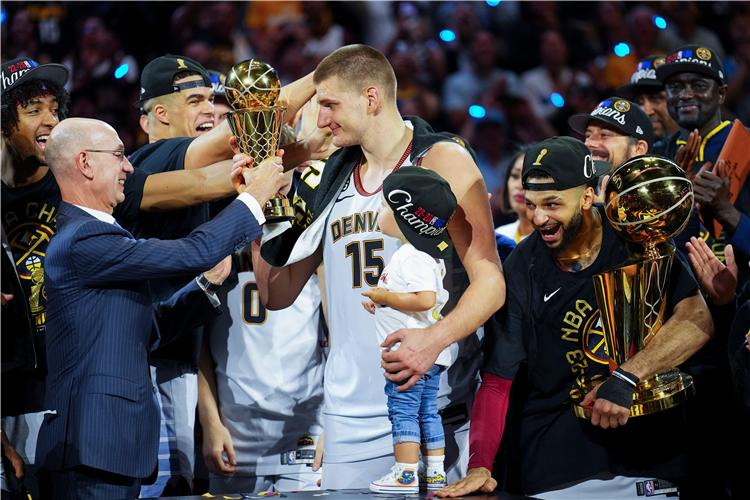
(Garbage Time theme song here)
The NBA playoffs came to a merciful end last Sunday with the Denver Nuggets dispatching the Miami Heat in a gentleman’s sweep to win their first NBA title. These playoffs began with a lot of promise—eight-seeded Miami’s upset of top-seeded Milwaukee as well as Sacramento-Golden State’s seven-game series were highlights—but in retrospect, it didn’t feel like the victorious teams in each round triumphed so much as the losing teams crumbled. The only team that could genuinely hold their head high after losing was Sacramento. Everyone else melted down. The poster child for this is probably the Boston Celtics, who struggled during match-ups against Atlanta and an equally uneven Philadelphia and then nearly came back from an 0-3 deficit in the Eastern Conference Finals before floundering in Game 7 against the Heat. But even runner-up Miami faded badly, dropping seven of their last nine games, including all four played on their home court.
So unlike Jimmy Butler’s Heat, LeBron James’s Lakers, Jayson Tatum’s Celtics, Joel Embiid’s 76ers, Steph Curry’s Warriors, Kevin Durant’s Suns, Kawhi Leonard’s Clippers, Giannis Antetokounmpo’s Bucks, gun afficionado Ja Morant’s Grizzlies, and even Luka Doncic’s non-playoff qualifying Mavericks, Nikola Jokic’s Denver Nuggets kept it together despite some late-season jitters and took home the title. As the Western Conference’s #1 seed, they’re not an undeserving champion, but some stiffer resistance would have bolstered their resume. Their most impressive series win came against the Phoenix Suns, who hadn’t lost a regular season game when their trade deadline acquisition, Kevin Durant, took the floor. Up 3-2 in the series, Denver travelled to Phoenix for Game 6, built an 81-51 lead by halftime, and extinguished the Suns on their home court. The loss cost Phoenix coach Monty Williams his job and put Chris Paul and Deandre Ayton’s futures with the team in jeopardy. The Nuggets would finish the playoffs with a 16-4 record, which has only been bested in the past twenty years by the 2016-17 Golden State Warriors (who went 16-1.)
The Nuggets’ victory has cemented center Nikola Jokic’s status as not only one of the elite players of his generation, but one of the elite centers of all-time. He may not rank among the league’s flashiest players, but he is among its most versatile, averaging just shy of a triple-double (24.5 points, 11.8 rebounds, 9.8 assists) for the season. (He also shot over 38% from behind the arc.) Over the past two months, he became the first player in NBA history to score 500 points, snag 250 boards, and dish 150 dimes in a single playoff run. The bulky 6’11” Serbian rarely dunks or even jumps and is neither fast nor explosive, yet he controls games with his deft passing (sometimes he looks like a basketball camp counselor clowning on a bunch of grade schoolers) and rebounding. He has to have the softest hands in the NBA. Jokic’s success would seem to refute the idea that the way to win in the NBA is to play relatively small and scatter shooters around the three-point line to both tee-up three-point shots and clear the lane for drives, but Jokic’s play simply suggests a different way forward, one built around versatile big men who can exploit with their shooting, passing, and size whatever defensive scheme the opposition throws at them. Now that his basketball rec league has concluded its season, the two-time NBA MVP can focus on his true love, racing horses.
The question on a lot of people’s minds now is whether Denver will become the NBA’s latest dynasty. The history of the modern NBA—that is, since Magic Johnson and Larry Bird came into the league—suggests NBA champions experience multiple years of success. Multiple dynastic teams attest to this: Johnson and Abdul-Jabbar’s Lakers, Bird’s Celtics, Jordan’s Bulls, Duncan’s Spurs, Shaq and Kobe’s Lakers, and Curry’s Warriors. Add to that list the championship dynasty built around LeBron James’ career in Miami, Cleveland, and Los Angeles, when he took a team to the Finals nine out of ten times between 2011 and 2020 and won four titles. Beyond that, not only is there a tendency for champions to repeat (the “Bad Boy” Pistons, Olajuwon’s Rockets), but there’s even a tendency for one-time champions (Philadelphia in 1983, Detroit in 2004, Boston in 2008, Dallas in 2011) to make the Finals at least one other time with their core player/s intact (Philadelphia in 1980 and 1982, Detroit in 2005, Boston in 2010, Dallas in 2006.)
So what teams don’t fit that pattern? Not many really. The 2006 Miami Heat are a weird exception because that team starred a former dynastic champion (Shaquille O’Neal) and the co-star of a future dynastic championship team (Dwyane Wade). There’s the 2019 Toronto Raptors, but the MVP of that series (Kawhi Leonard) was also the MVP of the 2014 series won by the San Antonio Spurs. That leaves the 2021 Milwaukee Bucks, led by Giannis Antetokounmpo. That history suggests that even if Jokic doesn’t win another title, he’ll at least get another shot at it when he’s in his prime.
But zoom out further and you’ll see what may be a new trend developing in the NBA. The NBA championship has been won by five different teams over the past five years (Denver, Golden State, Milwaukee, the Lakers, and Toronto.) The last time that happened was over forty years ago between 1977 and 1981, when Portland, Washington, Seattle, Los Angeles, and Boston each won a title (with Washington and Seattle also losing once in the Finals as well.) Might that suggest we’re entering an age of greater parity?
With Jokic and Murray, Denver is positioned to return to the Finals again either next season or in the near future, similar perhaps to how the Spurs with Tim Duncan made runs to the Finals in 1999, 2003, 2005, 2007, 2013, and 2014). I suspect, however, most teams feel the Nuggets aren’t so much a mountain that will need to be scaled as they are a team that can be matched. In fact, looking at teams as they are currently composed, I’d say there are at least eleven teams who feel they aren’t just a player away from contending but a player away from going into the season as the favorite to win it all. You could add to that another 2-3 teams who likely feel that if their talent enters their prime now, they would enter that conversation as well.
I’d also say many of these teams feel the urgency to win a championship now. The championship window is closing on James, Curry, Durant, Leonard, and Butler. Tatum, Embiid, Antetokounmpo, Doncic, and Phoenix’s Devin Booker are on the precipice and have legacies to establish or reinforce. These players will want their teams to get better; if their GMs don’t make a splash in free agency, some may ask out. There may not be an excuse to not get better either: There are stars on non-contenders and non-playoff teams (Damian Lillard in Portland, Bradley Beal in Washington, Zion Williamson in New Orleans) that could be moved, and entire rosters full of high-quality players (in Chicago, Toronto, and Utah) ready to be shipped out. Once these chips start moving around and free agents start signing, who knows what disgruntled star might become available.
The athleticism on display in the NBA is enough of a reason to follow it. No other league, however, adds as exciting an offseason, which is when the NBA’s soap operatic tendencies run wild. This year promises to be a particularly dramatic summer in the Association, as it won’t be enough to simply catch up with the Nuggets when nearly half the league feels they’re an all-star away from hanging a banner.




